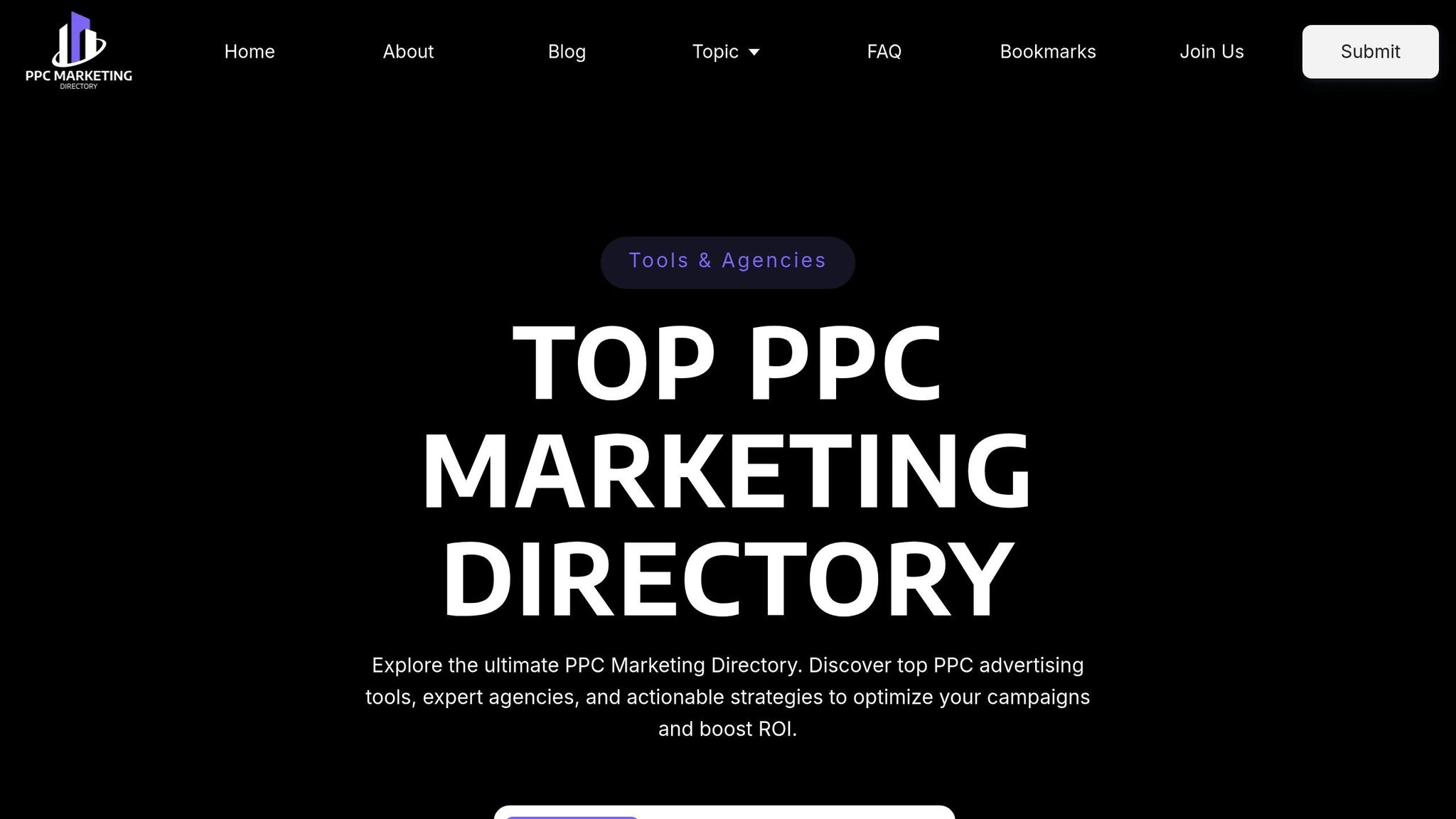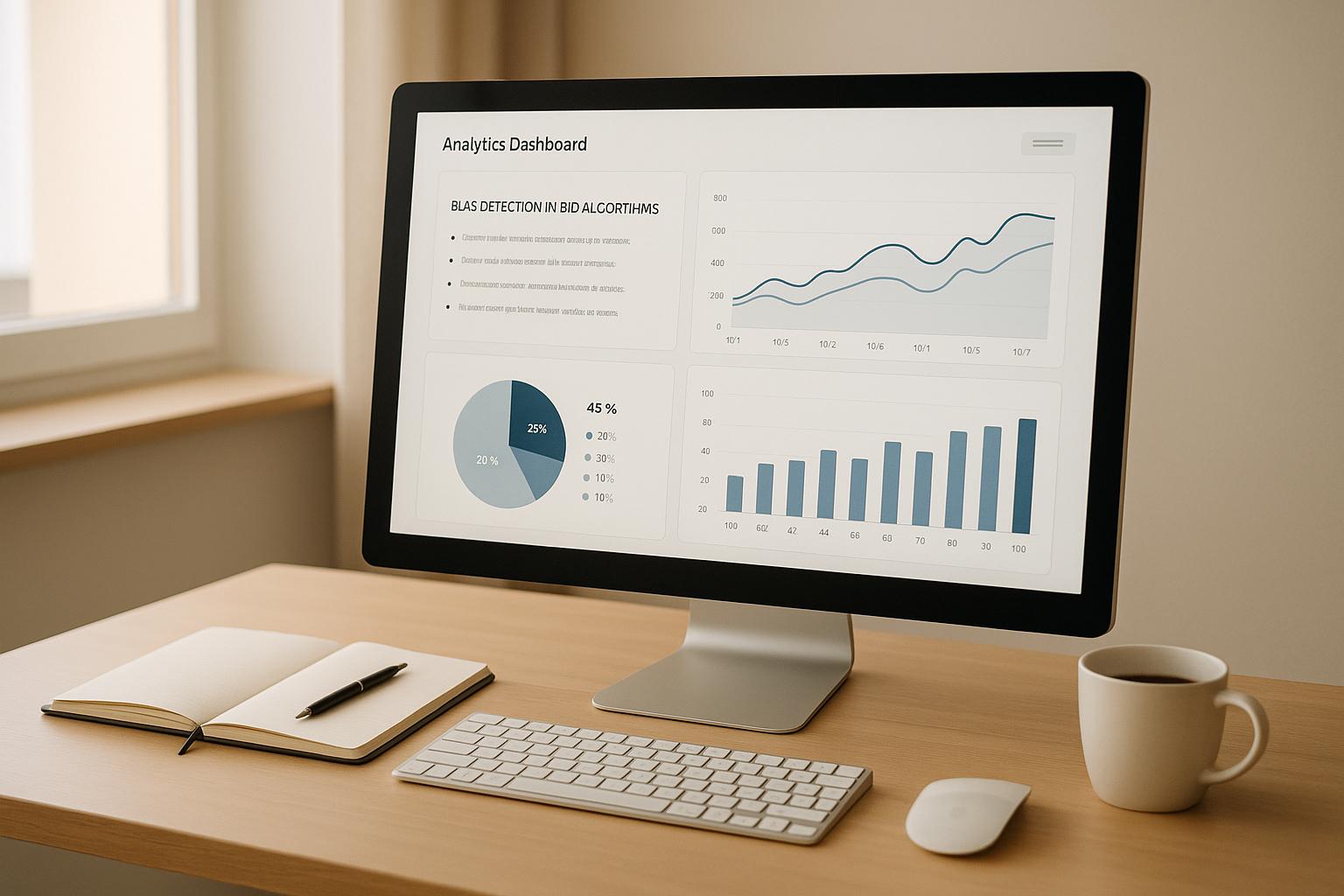Scalable data systems power ad bidding by processing billions of requests in milliseconds, ensuring advertisers can compete effectively in real-time auctions. These systems are essential for handling massive data volumes, enabling split-second decisions, and maximizing profitability in programmatic advertising.
Here’s what you need to know:
- Programmatic advertising dominates: It accounts for 89.3% of global display ad spending, with platforms handling up to 600 billion bid requests daily.
- Speed is critical: Response times under 100 milliseconds are required to remain competitive.
- Financial impact: AI-driven bidding systems can reduce costs by 30% and increase revenue by 25–50%.
- Core components: Real-time bidder microservices, data ingestion pipelines, and distributed databases ensure scalability and efficiency.
- Challenges: Traffic spikes, reliability issues, and data consistency are major hurdles, but advanced throttling and monitoring can mitigate them.
To thrive in ad bidding, businesses need modular architectures, efficient data pipelines, and robust databases. These systems not only process data at scale but also drive smarter, faster decision-making for better campaign outcomes.
Data Science in Programmatic Advertising Exploring Pricing Strategies for Real Time Bidding at Scale
Core Components of High-Volume Ad Bidding Architecture
Creating a scalable ad bidding system involves several essential components working in harmony. These systems must manage enormous data volumes, process bid requests, make split-second decisions, and respond quickly to maintain a competitive edge in programmatic advertising.
At its core, a high-volume ad bidding system relies on three main layers: real-time bidder microservices, data ingestion pipelines, and distributed databases. Together, these layers form a robust framework capable of handling the demands of modern ad bidding.
Real-Time Bidder Microservices
Microservices architecture is the backbone of today's ad bidding platforms, offering flexibility for scaling and quick updates. These services are designed to be stateless, enabling horizontal scaling and resilience against faults.
For example, RTB House processes an astounding 25 million requests per second with response times measured in milliseconds. Real-time bidder microservices calculate bids using live model inference outputs and data stored in high-speed caches like Aerospike. Each microservice is specialized - handling tasks like user profiling, budget tracking, or bid computation - which allows the system to scale specific components as needed.
To maximize efficiency, consider using AWS Graviton instances for bidder nodes and pairing them with Amazon EC2 Spot Instances for cost savings. Preloading bidder containers with necessary libraries and binaries can further reduce boot times, ensuring new instances are ready quickly during traffic spikes.
One challenge in this setup is managing the overhead of small message processing and garbage collection (GC). The ZGC garbage collector is a strong choice, as it performs most tasks concurrently with application threads, minimizing pauses. In contrast, G1 can cause frequent interruptions that increase request durations.
Data Ingestion and Processing Pipelines
Once bidder services are optimized, the next step is ensuring seamless data flow through efficient pipelines. These pipelines are critical for capturing bid requests and user signals in real time. For instance, TripleLift handles over 4 billion ad requests and 140 billion bid requests daily, generating 13 million unique rows in databases every hour and transferring 36 GB of new data into Apache Druid storage.
For data ingestion, tools like Kafka, Kinesis, or Debezium are commonly used, while Apache Flink is preferred for its low-latency processing and stateful stream computations. Although Spark remains an option for machine learning workloads, Flink's performance in real-time scenarios makes it a better fit for most bidding systems. To improve pipeline efficiency, consider partitioning Kafka by advertiser ID or event type to enable parallel processing.
The effectiveness of well-designed pipelines is evident in systems like The Trade Desk, which manages over 100,000 queries per second (QPS) from partners. Their infrastructure processes more than 800 billion queries daily while maintaining the low latency critical for real-time bidding. To ensure reliability at this scale, implementing data validation at ingestion points and monitoring pipelines in real time can help catch and fix issues early.
Distributed Databases for Scalability
The third pillar of a scalable ad bidding system is distributed databases, which provide the low-latency access needed for storing campaign data and user profiles. Popular choices include Aerospike and Amazon DynamoDB, both of which excel in handling high-speed data requirements. For instance, The Trade Desk uses Aerospike as both a real-time cache and a system of record, managing peak loads of up to 20 million writes per second.
For real-time analytics, Apache Druid and Apache Pinot are standout options. These databases allow quick drill-downs and complex queries on massive datasets. Reddit, for example, uses Apache Druid to ingest tens of gigabytes of ad event data per hour. Druid’s search and filtering capabilities enable Reddit to analyze user activity by age, location, and interests with impressive speed.
"Druid's key advantage is that it's designed for interactive analytics. We moved almost all of our Redshift tasks to Druid, which enabled us to load all of our dimensions into a single file and let Druid handle all of the indexing and optimization. Bottom line is if you want something that makes it quick and easy to slice and dice, use Druid."
Database architecture should also account for both hot and cold data patterns. Captify, for instance, uses a tiered approach where fresh data resides in HDFS, while historical information is stored in S3. For tasks like fraud detection and real-time decision-making, companies such as Ibotta leverage Apache Druid to integrate third-party vendor data with internal datasets, enabling instant access to detailed user profiles and behavioral insights.
Best Practices for Designing Scalable Data Systems
Creating scalable data systems requires thoughtful design principles that prioritize performance, adaptability, and cost efficiency. These systems are critical for managing the immense demands of real-time bidding (RTB). As data engineer Pratik Barjatiya puts it:
"Scalability is essential when building data pipelines because it ensures that the system can handle increased data volumes, user loads, and processing requirements without compromising performance."
Modularity and Extensibility
A modular design is key to building scalable systems. By breaking pipelines into independent components, businesses can quickly adapt to changing market dynamics or implement new bidding strategies. This approach ensures flexibility without disrupting the entire system.
Take Wayfair as an example. In 2019, the company spent over $1 billion on advertising across platforms like Google Search Ads, Facebook/Instagram Ads, and YouTube Ads. To optimize bidding for millions of ad placements, Wayfair's Bidding & Optimization Platform team developed a central system with specific goals: extensibility, observability, configurability, experimentation, and scalability.
This platform was designed to calculate "Wayfair's willingness to pay for any marketing opportunity, taking into account specific business goals". Because of its modular structure, the system could integrate features like proxy bidding, multilingual support, and mobile optimization without disrupting existing workflows.
Extensibility plays a crucial role in enabling rapid prototyping and seamless integration of new tools or services. For instance, one study showed that a real-time optimization algorithm outperformed other strategies 76% of the time in testing. To maintain consistency and reliability, companies should establish clear guidelines for developing extensions, test them thoroughly in a staging environment, and use robust version control systems to manage dependencies.
Monitoring and System Observability
To maintain top performance in high-stakes environments like RTB, system observability is non-negotiable. With standard RTB transactions taking roughly 100 milliseconds, monitoring ensures bottlenecks are identified and response times remain optimized.
Effective monitoring involves tracking the system's various layers simultaneously. This includes monitoring resource utilization to optimize real-time performance and conducting regular performance tests before rolling out new updates or extensions. Automated testing and monitoring help catch issues early, preventing disruptions in live operations.
Clear rules for data validation and cleansing are also essential. Accurate data ensures better insights and avoids poor bidding decisions. Tools like Apache Druid and Apache Pinot are invaluable for real-time analytics, enabling teams to analyze massive datasets quickly and make informed adjustments to bidding strategies.
By combining observability with modular design, businesses can create systems that are not only scalable but also cost-efficient.
Cost Management Through Cloud Infrastructure
A well-designed scalable system naturally leads to better cost management, especially when leveraging cloud infrastructure. Cloud solutions minimize hardware expenses and reduce maintenance efforts.
The secret to cutting costs lies in monitoring resource usage and employing serverless computing where it makes sense. This allows systems to scale automatically during peak bidding times, ensuring you only pay for what you use.
There are two main scaling strategies to consider:
- Horizontal scaling: Adding more instances to handle high volumes of concurrent users.
- Vertical scaling: Increasing the capacity of existing servers, suitable for smaller user bases with complex processes.
Choosing the right scaling approach for specific workloads can significantly optimize costs. Additionally, implementing CI/CD pipelines enables rapid deployment with minimal manual intervention, reducing operational overhead.
To ensure flexibility, an API-first approach is highly effective. Decoupling system components allows for easier upgrades, maintenance, and scaling while avoiding vendor lock-in. This approach also lets companies select the most cost-effective services for each part of their system.
Other cost-saving measures include database optimization and using content delivery networks (CDNs). By fine-tuning data access patterns and caching frequently accessed information closer to bidding servers, businesses can reduce both latency and infrastructure expenses.
sbb-itb-89b8f36
Tools and Technologies for Scalable Ad Bidding Systems
When building a scalable ad bidding system, the tools and technologies you choose play a pivotal role in managing massive data volumes with minimal delays. With the Real-Time Bidding (RTB) market projected to exceed $27 trillion by 2024, selecting the right solutions is key to staying competitive.
Real-Time Data Streaming Platforms
Real-time data streaming platforms are the foundation of scalable ad bidding systems. They enable the seamless ingestion, processing, and analysis of continuous data streams from multiple sources, all while maintaining low latency. The best platforms in this category are designed to handle increasing workloads by scaling horizontally and ensuring fault tolerance, high throughput, and real-time analytics.
Here are some leading tools in this space:
- Apache Kafka: A distributed, open-source platform known for its high throughput and fault-tolerant design.
- Confluent Cloud: Built on Apache Kafka, this enterprise-grade solution simplifies management and monitoring.
- Apache Flink: Offers a flexible programming model for both batch and streaming data processing.
- Cloud-native options: These include Amazon Kinesis, Google Cloud Dataflow, and Azure Stream Analytics, all of which integrate with their respective cloud ecosystems to simplify streaming data management.
Take, for instance, VerticalServe’s implementation of a real-time AdTech bidding platform using Confluent Kafka and Apache Flink. This system processes 1 terabyte of data per hour while meeting strict service-level agreements (SLAs), optimizing ad placements, and driving programmatic advertising revenue.
To get the most out of these platforms, consider adopting event-driven architectures, partitioning data for better organization, and scaling nodes to meet growing demands. Pairing these efforts with robust storage solutions ensures the system remains efficient and responsive.
Data Storage Solutions
Efficient storage is just as important as real-time data processing. Scalable ad bidding systems demand storage solutions that offer high performance, low latency, and the ability to handle large datasets. Typically, these systems combine NoSQL databases for rapid operations with data lakes for historical analysis and machine learning model training.
One standout example is Aerospike, a platform that delivers sub-millisecond latency at scale while cutting infrastructure costs by up to 80%. It processes 10 times more queries per node compared to older systems, making it ideal for high-frequency bidding scenarios.
"Aerospike is Adform's secret weapon - the enabling data store that allows us to do real-time bidding and make money."
– Peter Milne, Adform Senior Architect
When choosing a storage solution, focus on factors like capacity, performance (IOPS, throughput, latency), reliability, security, and recovery capabilities. For unstructured data, object storage offers limitless scalability, while software-defined storage (SDS) provides flexibility by abstracting storage resources from hardware. Additionally, leveraging AWS Graviton processors can improve price performance by 40% compared to x86-based instances. To optimize storage usage, implement lifecycle management policies and use tiering to classify data based on how frequently it’s accessed.
Machine Learning and Predictive Models
Machine learning (ML) takes ad bidding to the next level by enabling smarter, data-driven decisions in real time. For example, Adaptive CPM - a machine learning-based approach - has been shown to double win rates in campaigns, jumping from 20% to 40%. ML algorithms can predict bid outcomes, reduce overspending, and improve click-through rates (CTR) by up to 30% for advertisers who adopt ML-driven strategies.
Here’s how ML can enhance ad bidding:
- Audience targeting: Analyze vast datasets to pinpoint and engage specific audience segments.
- Bid optimization: Predict the ideal bid prices based on historical trends.
- Ad fraud detection: Identify and block fraudulent activity in real time.
- Real-time ad placement: Determine the best timing and placement for maximum impact.
- Budget allocation: Distribute budgets efficiently across campaigns to maximize ROI.
Using Industry Resources for Scalable PPC Campaigns
Creating scalable ad bidding systems goes beyond just technical know-how - it requires the right mix of tools and services to handle high-volume campaigns effectively. While having a solid data infrastructure is important, selecting the right PPC marketing tools plays a huge role in achieving scalable results. This is where curated industry resources come into play, offering businesses a way to streamline their PPC efforts while managing complex bidding systems. One such resource is specialized directories that connect businesses with tools tailored for scalable ad bidding.
Role of Directories in PPC Marketing
Curated directories act as a bridge between businesses and the specialized tools they need for successful PPC campaigns. These platforms simplify the often daunting task of identifying and evaluating solutions that support scalable ad bidding systems. Beyond just listing tools, they provide valuable market insights and competitive intelligence, helping businesses find solutions that align with their growth needs and scalability goals. PPC tools, in particular, help automate repetitive tasks, saving time and minimizing errors.
With Google Ads generating an average ROI of 200% - $2 in revenue for every $1 spent - the stakes are incredibly high when it comes to choosing the right tools.
"Reporting to revenue and scaling is the hardest part of paid search." - Jay Baron, CEO of Elevate Demand
This quote highlights why directories are so valuable. Instead of spending weeks researching individual tools, businesses can use curated platforms to quickly pinpoint options that offer real-time performance tracking, budget management, and the capacity to handle large-scale bidding scenarios. The numbers back this up: PPC advertising traffic has a 50% higher conversion rate than organic site visitors. These directories don’t just save time - they also provide access to tools that optimize every aspect of PPC marketing.
Top PPC Marketing Directory Features

The Top PPC Marketing Directory caters to businesses aiming to scale their ad bidding systems by offering a well-rounded set of features. These include tools for campaign management, bid adjustments, keyword research, ad copy optimization, A/B testing, retargeting, performance tracking, and landing page improvements.
Bid management is particularly critical for scalable systems. The directory helps businesses find tools that can automate keyword bidding, ensuring they stay competitive on search engine results pages while managing costs effectively.
Performance tracking is another key feature for large-scale campaigns. Steven Dang, VP of Growth & Strategy at HawkSEM, explains:
"We typically scale PPC campaigns when we perceive that we are reading a state of diminishing returns or plateauing when it comes to existing PPC campaigns"
Retargeting and remarketing tools also play a significant role in boosting campaign effectiveness. Remarketing campaigns, for instance, can achieve up to a 900% higher click-through rate. For businesses managing a high volume of bid requests, these tools can drive meaningful improvements in overall performance.
The directory also supports programmatic advertising by helping businesses identify solutions that integrate with real-time bidding systems, data streaming platforms, and machine learning technologies. This ensures the technical infrastructure can handle the demands of large-scale PPC efforts.
What sets the Top PPC Marketing Directory apart is its curated approach. Instead of overwhelming users with endless options, it focuses on solutions with proven success in managing enterprise-level campaigns. This saves businesses valuable time during the evaluation process and minimizes the risk of choosing tools that fail to scale with their operations.
The platform offers multiple listing tiers, ranging from free basic listings to premium placements. This structure ensures that businesses can access both well-established enterprise tools and emerging solutions that bring fresh ideas to the challenges of scalable ad bidding.
Conclusion and Key Takeaways
Building scalable data systems for ad bidding isn't just a technical necessity - it’s a game-changer. These systems handle billions of requests in milliseconds, ensuring advertisers stay competitive while achieving unparalleled efficiency.
But it’s not just about processing massive volumes of data. Scalable systems excel at delivering real-time, precise bid decisions. By training machine learning models on larger datasets, they enable smarter bidding strategies that adjust to market conditions in real time. This adaptability directly improves prediction accuracy and campaign performance.
The backbone of these advancements? Scalable cloud computing.
"Cloud computing scalability is the ability to increase or decrease your IT resources on demand when your organization's need for computing speed or storage changes." - Schuyler Brown, Chairman of the Board, StrongDM
This flexibility is crucial. Scalable systems ensure consistent performance across platforms and devices, even during traffic spikes. They also help optimize ad spend, allowing businesses to handle more bids without a proportional rise in operational costs - an efficiency that directly impacts profitability.
To build such systems, focus on modular design, horizontal scaling, distributed storage (like HDFS or Amazon S3), asynchronous processing (using tools like Kafka), and robust error handling. These elements form the core of scalable architectures that can adapt to the ever-changing demands of programmatic advertising.
The right tools also play a pivotal role. For instance, businesses generate an average of $2 in revenue for every $1 spent on Google Ads. Selecting the right PPC tools is critical for maximizing ROI. Platforms like the Top PPC Marketing Directory simplify this process by offering curated solutions for bid management, performance tracking, and machine learning-powered optimization. These tools seamlessly integrate with scalable systems, creating a synergy that drives better results.
Looking ahead, the need for scalable infrastructure will only grow. By 2025, global data creation is expected to reach 180 zettabytes. Modular architectures and real-time data pipelines will be essential for managing this massive influx of information. Businesses that invest in these capabilities now will be well-positioned to lead in areas like programmatic advertising, real-time bidding, and AI-driven campaign strategies.
Key takeaway: Scalable data systems are the foundation of success in modern advertising. Prioritize modular, horizontally scalable architectures, leverage advanced tools, and continuously monitor and refine your systems to stay ahead in this rapidly evolving landscape.
FAQs
How can scalable data systems boost the performance and profitability of ad bidding?
Scalable data systems are a game-changer for improving ad bidding, primarily because they enable real-time bid processing. This capability allows marketers to make faster decisions, target audiences more effectively, and ultimately boost conversion rates - all while keeping ad spend in check. The result? Campaigns that are not only more efficient but also more profitable.
Another advantage is their ability to integrate effortlessly with multiple data sources. These systems are built with high availability and fault tolerance in mind, ensuring they can maintain top-notch performance even as traffic and data demands grow. By minimizing bottlenecks and optimizing speed, scalable architectures allow ad platforms to handle increasing workloads without compromising quality. This translates to a better return on investment (ROI) and a seamless experience for users.
What are the main components of a scalable ad bidding system, and how do they work together?
A well-functioning ad bidding system relies on several core components: ad exchanges, demand-side platforms (DSPs), real-time bidding (RTB) engines, and bid management systems. Together, these elements manage billions of ad requests daily while keeping latency to an absolute minimum.
Here’s how it works: When someone visits a website or uses an app, an ad request is generated and sent to ad exchanges. These exchanges pass the request along to multiple DSPs. Each DSP then analyzes the request, taking into account factors like user data, targeting preferences, and the advertiser’s budget. Based on this evaluation, the DSP submits a bid. An auction determines the highest bid, and the corresponding ad is displayed to the user.
To process this enormous volume efficiently, these systems rely on real-time data pipelines, low-latency algorithms, and scalable infrastructure. This setup ensures that ad auctions are completed in just milliseconds, allowing businesses to fine-tune their campaigns and stay competitive in fast-paced markets.
How can businesses effectively manage costs when building scalable data systems for ad bidding?
To keep costs under control, businesses can take advantage of automated bidding strategies such as Target CPA or Target ROAS. These tools use AI to adjust bids in real-time, cutting down on manual work and helping to avoid unnecessary spending.
It’s smart to begin with smaller budgets and increase spending step by step while closely tracking key performance metrics. This method prevents overspending as you scale and ensures resources are used wisely. By setting clear goals that can grow over time and using automation effectively, businesses can manage costs efficiently in high-volume ad bidding scenarios.


